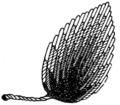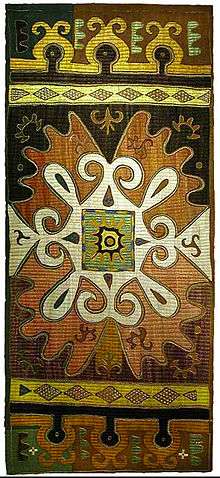Satin stitch

In sewing and embroidery, a satin stitch or damask stitch is a series of flat stitches that are used to completely cover a section of the background fabric.[1] Narrow rows of satin stitch can be executed on a standard sewing machine using a zigzag stitch or a special satin stitch foot.
In order to maintain a smooth edge, shapes can be outlined with back, split or chain stitch before the entire shape including the outline is covered with satin stitch.
Machine-made satin stitch is often used to outline and attach appliques to the ground fabric.[2]
Variants
Variants of the satin stitch include:
- Bourdon stitch - a tightly spaced, decorative stitch typically used for monograms and decorative purposes.[3][4]
- Brick stitch, in which alternate rows of satin stitches are offset by half the stitch length. Worked in several related colors, brick stitch allows stepped shading. (Brick stitch is also the name of a beadwork technique.)
- Encroaching satin stitch, in which the top of each row of stitches is set between the bottom of the stitches on the previous row.
- Long-and-short stitch, used for fine shading; in the first row of satin stitches, every other stitch is half the length of its neighbors. Subsequent rows in related colors are all of the same length.[5]
- Padded satin stitch, in which shapes are filled with rows of small running stitches which are then covered with satin stitches.[6]
Thread
Satin stitch is frequently made with embroidery thread, which has less twist than standard sewing thread. This gives a more uniform effect, with the individual threads' filaments merging.
While good sewing threads produce acceptable satin stitch, low quality threads usually do not sit straight, and produce an uneven result. The colour of each thread usually does not matter.
Stitch gallery
 Satin stitch
Satin stitch Bourdon stitch
Bourdon stitch Brick stitch
Brick stitch Encroaching satin stitch
Encroaching satin stitch Long-and-short stitch
Long-and-short stitch
See also
Notes
- ↑ Reader's Digest Complete Guide to Needlework. The Reader's Digest Association, Inc. (March 1992). ISBN 0-89577-059-8, p. 48
- ↑ Complete Guide to Needlework, p. 196-197
- ↑ Maitra, K. K. (2007). Encyclopaedic Dictionary of Clothing and Textiles. Mittal Publishing. p. 44. ISBN 9788183242059.
- ↑ Duss, Martena; Sissi Holleis (2011). Sweat Shop Paris: Lessons in Couture from the Sewing Cafe. Andrews McMeel Publishing. p. 158. ISBN 9781449408404.
- ↑ Christie, Grace (Mrs. Archibald H.): Embroidery and Tapestry Weaving, London, John Hogg, 1912, Chapter V.
- ↑ Complete Guide to Needlework, p. 49
References
| Wikimedia Commons has media related to embroidery stitches. |
- Caulfield, S.F.A., and B.C. Saward, The Dictionary of Needlework, 1885.
- Christie, Grace (Mrs. Archibald H.): Embroidery and Tapestry Weaving, London, John Hogg, 1912; e-text at Project Gutenberg
- Reader's Digest. Complete Guide to Needlework. The Reader's Digest Association, Inc. (March 1992). ISBN 0-89577-059-8


